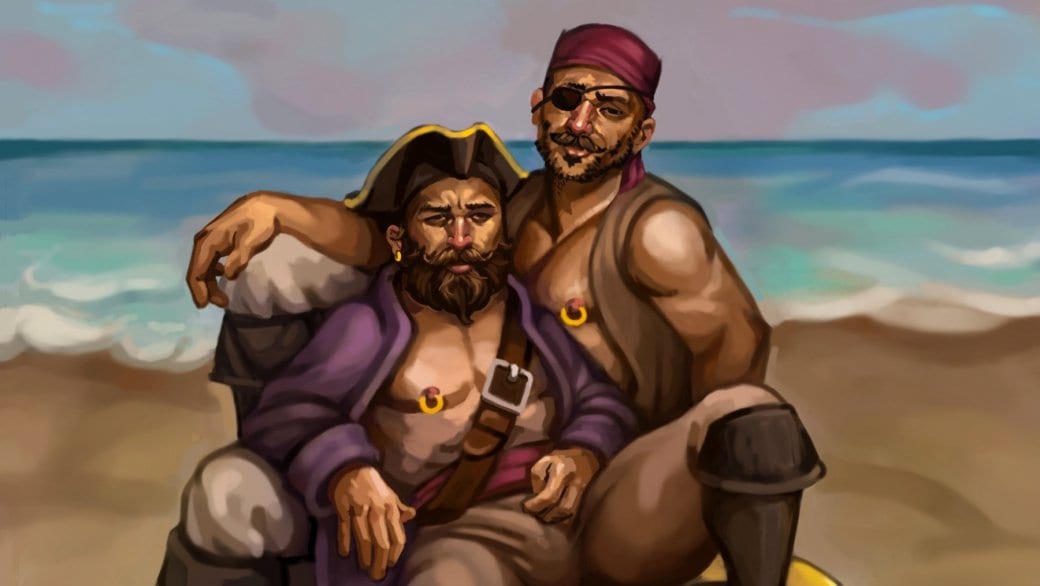After pirates captured Captain John Evans’s ship and pilfered the clothing in his cabin, they treated him to an elaborate — and to my mind, wonderfully faggy — display. Writing in 1728, Evans recalls that, “the Fellows . . . met with a Leather Powder Bag and Puff, with which they had powder’d themselves from Head to Foot, walk’d the Decks with their Hats under their Arms, minced their Oaths, and affected the Airs of a Beau, with an Aukwardness [that] would have forced a Smile from a Cynick.”
BR Burg’s Sodomy and the Pirate Tradition: English Sea Rovers in the Seventeenth-Century Caribbean (first published in 1983) says Evans’s assailants didn’t sashay up and down the deck out of effeminacy. Pirates needed traditionally masculine traits, such as stamina, courage and ferocity in battle, in order to survive, and whenever they paraded about it was purely in celebration of a victory and after having captured a ship containing such garments (let alone that such attire was considered masculine at that time). However, he argues they were no strangers to man-on-man action.
Burg says in his introduction that his study is not a historical work, because it relies heavily on psychology and sociology with the goal of finding “coherence” in a “strictly defined male group.” What sort of work it is, is up to academia to decide (and surely this over-three-decades-old work has already been judged), but it’s clear to me that Burg gives a plausible (if somewhat tainted by his dated views on gender) account of the role of sodomy in the fascinating lives of the English pirates who plundered the Caribbean in the 17th century.

(Original illlustration by Yigi Chang/Daily Xtra)
Most of the men who became pirates started out as homeless boys wandering the roads of England in all-male bands, finding their way onto ships with all-male crews. Ending up in the Caribbean, where English inhabitants were either men (landowners or workers) or women who were off-limits to the common rabble, these pirates were either lucky homosexuals or heterosexuals quite willing to engage in sodomy — after all, it was, and had long been, the only sexual option open to them.
On the rare occasions when they were around women, pirates were very uncomfortable. Men who cared for women were ridiculed, and some ships even had rules against fraternising with them. One pirate, Captain William Cowley, even blamed women for a storm he encountered. He wrote: “ . . . and discoursing of the Intrigues of Women, there arose a prodigious Storm, which did continue till the last Day of the Month . . . so that we concluded the discoursing of Women at Sea was very unlucky, and occasioned the Storm.”
There were no such qualms when it came to boys. Captains, who usually trained teen boys into able-bodied sailors on a one-on-one basis, often fell in love with them. It wasn’t always sexual, but a boy at this stage in his career as a pirate would have been well-prepared if it turned out to be so. The infamous pirate Blackbeard was brutal with seemingly everyone except his boy. When William Dampier’s boy’s mother died, the boy’s anguish upset Dampier greatly. Captain Charles Swan always (ahem) shared his booty with his boy.
There were also instances of pirates of similar ages being, for all intents and purposes, married to one another. Sometimes these began as instances of “matelotage,” where a hard-up sailor would sell himself to another. Pirate husbands would share property with one another, and if one died, often the other would inherit. These bonds were quite strong. When Captain Robert Bartholomew killed a drunken sailor for insulting him, the dead sailor’s husband threw him over a cannon and beat him (a terrible risk that shows his intense devotion to his dead partner).
Burg’s text — these days, quite a hard-to-find book — occasionally makes hard-to-swallow leaps of logic, but it’s redeemed by the parts that paint a picture of the relationships men had with each other and what they got up to beneath the sheets (he reckons the poor hygiene may have rendered oral sex unsavoury — I do thoroughly intend the pun — but the lack of proscription and privacy would have made anal sex rampant and public). I also enjoy such amusing artifacts as this excerpt from a letter written by Margaret Heathcote from Antigua to her cousin John Winthrop Jr in 1655: “And truely, Sir, I am not so much in love with any as to goe much abroad … they all be a company of sodomites that lives here.”
History Boys appears on Daily Xtra on the first and third Tuesday of every month. You can also follow them on Facebook.


 Why you can trust Xtra
Why you can trust Xtra


